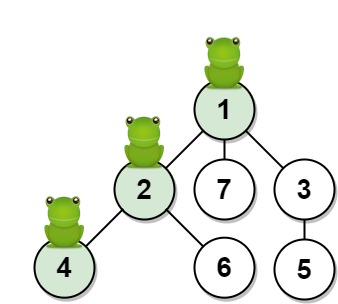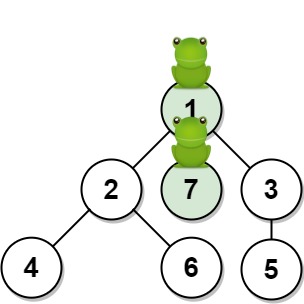- {x}
- Get the Second Most Recent Activity
- Increasing Decreasing String
- Find the Longest Substring Containing Vowels in Even Counts
- Longest ZigZag Path in a Binary Tree
- Maximum Sum BST in Binary Tree
- Generate a String With Characters That Have Odd Counts
- Number of Times Binary String Is Prefix-Aligned
- Time Needed to Inform All Employees
- Frog Position After T Seconds
- Replace Employee ID With The Unique Identifier
- Find a Corresponding Node of a Binary Tree in a Clone of That Tree
- Lucky Numbers in a Matrix
- Design a Stack With Increment Operation
- Balance a Binary Search Tree
- Maximum Performance of a Team
- Total Sales Amount by Year
- Find the Distance Value Between Two Arrays
- Read More...

Frog Position After T Seconds
Given an undirected tree consisting of n vertices numbered from 1 to n. A frog starts jumping from vertex 1. In one second, the frog jumps from its current vertex to another unvisited vertex if they are directly connected. The frog can not jump back to a visited vertex. In case the frog can jump to several vertices, it jumps randomly to one of them with the same probability. Otherwise, when the frog can not jump to any unvisited vertex, it jumps forever on the same vertex.
The edges of the undirected tree are given in the array edges, where edges[i] = [ai, bi] means that exists an edge connecting the vertices ai and bi.
Return the probability that after t seconds the frog is on the vertex target. Answers within 10-5 of the actual answer will be accepted.
Example 1:

Input: n = 7, edges = [[1,2],[1,3],[1,7],[2,4],[2,6],[3,5]], t = 2, target = 4 Output: 0.16666666666666666 Explanation: The figure above shows the given graph. The frog starts at vertex 1, jumping with 1/3 probability to the vertex 2 after second 1 and then jumping with 1/2 probability to vertex 4 after second 2. Thus the probability for the frog is on the vertex 4 after 2 seconds is 1/3 * 1/2 = 1/6 = 0.16666666666666666.
Example 2:

Input: n = 7, edges = [[1,2],[1,3],[1,7],[2,4],[2,6],[3,5]], t = 1, target = 7 Output: 0.3333333333333333 Explanation: The figure above shows the given graph. The frog starts at vertex 1, jumping with 1/3 = 0.3333333333333333 probability to the vertex 7 after second 1.
Constraints:
1 <= n <= 100edges.length == n - 1edges[i].length == 21 <= ai, bi <= n1 <= t <= 501 <= target <= n
1377. Frog Position After T Seconds
Problem Description
This problem involves calculating the probability of a frog reaching a target vertex on an undirected tree after a specific number of seconds. The frog starts at vertex 1 and can jump to an unvisited adjacent vertex in each second. If multiple unvisited vertices are available, it jumps to each with equal probability.
Solution: Breadth-First Search (BFS)
The optimal approach uses Breadth-First Search (BFS) to traverse the tree. We maintain a queue to track the frog's position and the probability of reaching that position.
Algorithm:
-
Graph Representation: Construct an adjacency list to represent the tree.
g[u]stores the list of vertices adjacent to vertexu. -
Initialization:
- Create a queue
qinitially containing(1, 1.0), representing the frog's starting position (vertex 1) and initial probability (1.0). - Create a boolean array
visto track visited vertices, initializingvis[1] = true.
- Create a queue
-
BFS Traversal: Iterate while the queue is not empty and the time
tis greater than or equal to 0. In each iteration:- Process all vertices currently in the queue (the number of vertices equals the
len(q)at the beginning of the loop). - For each vertex
uand probabilitypdequeued fromq:- Target Check: If
uis thetargetvertex:- If
cnt(number of unvisited neighbors) is 0 (frog is stuck) or it's the exact timet, returnp. Otherwise, return 0 (frog couldn't reach the target at the exact time).
- If
- Neighbor Exploration: Otherwise (
uis not thetarget):- Calculate
cntthe number of unvisited neighbors ofu. Adjustcntby subtracting 1 ifuisn't the starting node (to avoid counting the parent in the first step). - For each unvisited neighbor
v:- Mark
vas visited (vis[v] = true). - Enqueue
(v, p / cnt)toq, distributing the probability equally among unvisited neighbors.
- Mark
- Calculate
- Target Check: If
- Decrement
tto simulate the passage of time.
- Process all vertices currently in the queue (the number of vertices equals the
-
Return 0: If the queue becomes empty or
tbecomes negative before reaching the target, return 0 (frog didn't reach the target).
Time Complexity: O(N), where N is the number of nodes in the tree. BFS visits each node at most once.
Space Complexity: O(N) in the worst case to store the queue and the vis array.
Code Examples (Python)
from collections import defaultdict, deque
class Solution:
def frogPosition(self, n: int, edges: list[list[int]], t: int, target: int) -> float:
g = defaultdict(list)
for u, v in edges:
g[u].append(v)
g[v].append(u)
q = deque([(1, 1.0)])
vis = [False] * (n + 1)
vis[1] = True
while q and t >= 0:
for _ in range(len(q)):
u, p = q.popleft()
cnt = len(g[u]) - int(u != 1) # Adjust cnt for starting node
if u == target:
return p if cnt * t == 0 else 0 # Check for stuck or exact time
for v in g[u]:
if not vis[v]:
vis[v] = True
q.append((v, p / cnt))
t -= 1
return 0
The code in other languages (Java, C++, Go, TypeScript, C#) provided in the original response follows the same algorithmic approach, differing only in syntax and data structure implementations. The core logic of BFS and probability distribution remains consistent across all the languages.